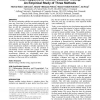Free Online Productivity Tools
i2Speak
i2Symbol
i2OCR
iTex2Img
iWeb2Print
iWeb2Shot
i2Type
iPdf2Split
iPdf2Merge
i2Bopomofo
i2Arabic
i2Style
i2Image
i2PDF
iLatex2Rtf
Sci2ools
CHI
2007
ACM
2007
ACM
What happened to remote usability testing?: an empirical study of three methods
The idea of conducting usability tests remotely emerged ten years ago. Since then, it has been studied empirically, and some software organizations employ remote methods. Yet there are still few comparisons involving more than one remote method. This paper presents results from a systematic empirical comparison of three methods for remote usability testing and a conventional laboratorybased think-aloud method. The three remote methods are a remote synchronous condition, where testing is conducted in real time but the test monitor is separated spatially from the test subjects, and two remote asynchronous conditions, where the test monitor and the test subjects are separated both spatially and temporally. The results show that the remote synchronous method is virtually equivalent to the conventional method. Thereby, it has the potential to conveniently involve broader user groups in usability testing and support new development approaches. The asynchronous methods are considerably more ...
CHI 2007 | Human Computer Interaction | Keywords Remote Testing | Remote Synchronous Method | Remote Usability Testing |
| Added | 30 Nov 2009 |
| Updated | 30 Nov 2009 |
| Type | Conference |
| Year | 2007 |
| Where | CHI |
| Authors | Henrik Villemann Nielsen, Jan Stage, Morten Sieker Andreasen, Simon Ormholt Schrøder |
Comments (0)

